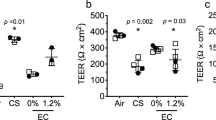Summary
Following the working hypothesis that aromatic hydrocarbons are most responsible for the tumor-inducing effect of cigarette smoke condensate we tried to obtain fractions largely concentrated with aromatic hydrocarbons.
The tumor-inducing activity of a standard cigarette condensate was compared with the nitromethane fraction of condensate representing 6.8 weight % of the whole condensate and containing nearly all aromatic hydrocarbons. Separating fraction V further into fraction VI representing only 1% of the whole condensate and containing more than 85% of aromatic hydrocarbons, it was possible, to compare the single fractions and corresponding recombinates in its efficiency with standard condensate.
Experiments revealed the possibility of enriching tumor-inducing substances of the condensate in that way that the activity of fraction V is 17 times and that of fraction VI 50 times stronger than the standard condensate. The activity of fraction V is not completely converted to fraction VI during fractionating as it should have been according to the working hypothesis.
Results of experiments may lead to the conclusion that once the stress must be given to the enriched polycyclic hydrocarbons in the fraction for the tumor-inducing effect and secondly that besides the polycyclic hydrocarbons, being only a small weight proportion, other substances are significant for the tumor-inducing effect.
Zusammenfassung
Ausgehend von der Arbeitshypothese, daß die aromatischen Kohlenwasserstoffe für die tumorerzeugende Wirkung des Zigarettenrauchkondensates verantwortlich zu machen sind, wurde versucht, Fraktionen zu gewinnen, in denen die aromatischen Kohlenwasserstoffe weitgehend angereichert vorliegen.
Verglichen wurde die tumorerzeugende Wirkung des Kondensates einer Standardzigarette mit der Nitromethanfraktion V des Kondensates, die 6,8 Gew.-% des Gesamtkondensates ausmacht und nahezu alle aromatischen Kohlenwasserstoffe enthält. Bei weiterer Auftrennung der Fraktion V in eine Fraktion VI, die nur noch 1% des Gesamtkondensates ausmacht und über 85% der aromatischen Kohlenwasserstoffe enthält, war es möglich, die Einzelfraktionen und die entsprechenden Rekombinate in ihrer Wirkungsweise mit dem Standardkondensat zu vergleichen.
Die Versuche ließen erkennen, daß es möglich ist, die tumorerzeugenden Wirkstoffe des Kondensates so stark anzureichern, daß die Fraktion V eine 17- und die Fraktion VI eine 50mal so starke Wirkung wie das Standardkondensat erkennen lassen. Bei der Fraktionierung wird die Aktivität der Fraktion V allerdings nicht vollständig in die Fraktion VI überführt.
Die Versuchsergebnisse erlauben den Schluß, daß den in den Fraktionen angereicherten polycyclischen Kohlenwasserstoffen eine wesentliche Bedeutung für die tumorerzeugende Wirkung zukommt, lassen aber auch erkennen, daß neben den polycyclischen Kohlenwasserstoffen — die in diesen Fraktionen nur einen geringen Gewichtsanteil ausmachen-andere Stoffe für die tumorerzeugende Wirkung bedeutsam sind.
Similar content being viewed by others
Literatur
Day, T. D.: Carcinogenic action of cigarette smoke condensate on mouse skin. Brit. J. Cancer 21, 56–81 (1967).
Dontenwill, W., Elmenhorst, H., Harke, H.-P., Reckzeh, G., Weber, K. H., Misfeld, J., Timm, J.: Experimentelle Untersuchungen über die tumorerzeugende Wirkung von Zigarettenrauch-Kondensaten an der Mäusehaut. I. Z. Krebsf. 73, 265–284 (1970).
Druckrey, H., Schildbach, A.: Quantitative Untersuchungen zur Bedeutung des Benzpyrens für die carcinogene Wirkung von Tabakrauch. Z. Krebsforsch. 65, 465–470 (1963).
Elmenhorst, H., Grimmer, G.: Polycyclische Kohlenwasserstoffe aus Zigarettenrauchkondensat. Eine Methode zur Fraktionierung großer Mengen für Tierversuche. Z. Krebsforsch. 71, 66–73 (1968).
Grimmer, G.: Persönliche Mitteilung 1969.
Lazar, P., Chouroulinkov, I., Libermann, C., Guerin, M.: Benzo(a)pyrene content and carcinogenicity of cigarette smoke condensate. Results of short-term and long-term tests. J. nat. Cancer Inst. 37, 573–579 (1966).
Roe, F. J. C., Salaman, M. H., Cohen, J.: Incomplete carcinogens in cigarette smoke condensate: Tumour-promotion by a phenolic fraction. Brit. J. Cancer 13, 623–633 (1959).
Wynder, E. L., Wright, G.: A study of tobacco carcinogenesis. Cancer 10, 255–271 (1957).
Author information
Authors and Affiliations
Rights and permissions
About this article
Cite this article
Dontenwill, W., Elmenhorst, H., Harke, H.P. et al. Experimentelle Untersuchungen über die tumorerzeugende Wirkung von Zigarettenrauch-Kondensaten an der Mäusehaut. Z Krebs-forsch 73, 305–314 (1970). https://doi.org/10.1007/BF00524409
Received:
Issue Date:
DOI: https://doi.org/10.1007/BF00524409




